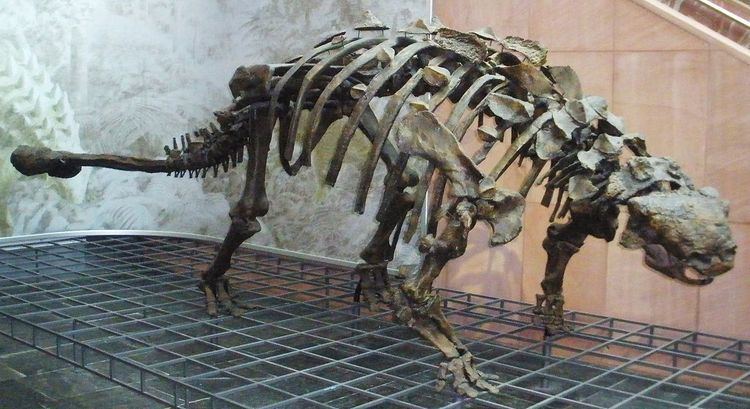 | ||
This timeline of ankylosaur research is a chronological listing of events in the history of paleontology focused on the ankylosaurs, quadrupedal herbivorous dinosaurs who were protected by a covering bony plates and spikes and sometimes by a clubbed tail. Although formally trained scientists did not begin documenting ankylosaur fossils until the early 19th century, Native Americans had a long history of contact with these remains, which were generally interpreted through a mythological lens. The Delaware people have stories about smoking the bones of ancient monsters in a magic ritual to have wishes granted and ankylosaur fossils are among the local fossils that may have been used like this. The Native Americans of the modern southwestern United States tell stories about an armored monster named Yeitso that may have been influenced by local ankylosaur fossils. Likewise, ankylosaur remains are among the dinosaur bones found along the Red Deer River of Alberta, Canada where the Piegan people believe that the Grandfather of the Buffalo once lived.
Contents
- Prescientific
- 1830s
- 1840s
- 1850s
- 1860s
- 1870s
- 1880s
- 1890s
- 1900s
- 1910s
- 1920s
- 1930s
- 1940s
- 1950s
- 1960s
- 1970s
- 1980s
- 1990s
- 2000s
- 2010s
- References
The first scientifically documented ankylosaur remains were recovered from Early Cretaceous rocks in England and named Hylaeosaurus armatus by Gideon Mantell in 1833. However, the Ankylosauria itself would not be named until Henry Fairfield Osborn did so in 1923 nearly a hundred years later. Prior to this, the ankylosaurs had been considered members of the Stegosauria, which included all armored dinosaurs when Othniel Charles Marsh named the group in 1877. It was not until 1927 that Alfred Sherwood Romer implemented the modern use of the name Stegosauria as specifically pertaining to the plate-backed and spike-tailed dinosaurs of the Jurassic that form the ankylosaurs' nearest relatives. The next major revision to ankylosaur taxonomy would not come until Walter Coombs divided the group into the two main families paleontologists still recognize today; the nodosaurids and ankylosaurids. Since then, many new ankylosaur genera and species have been discovered from all over the world and continue to come to light. Many fossil ankylosaur trackways have also been recognized.
Prescientific
1830s
1832
1833
1840s
1842
Early April
1843
1844
1850s
1856
1858
1860s
1865
1867
1869
1870s
1871
1875
1879
1880s
1881
1882
1888
1889
1890s
1890
1892
1893
1900s
1901
1902
1905
1908
1909
1910s
1914
1915
1918
1919
1920s
1923
1924
1927
1928
1929
1930s
1930
1932
1933
1934
1935
1936
1940s
1940
1950s
1952
1953
1955
1956
1960s
1960
1963
1964
1969
1970s
1970
1971
1972
1977
1978
1979
1980s
1980
1982
1983
1984
1986
1987
1988
1989
1990s
1990
1991
1993
1994
1995
1996
1997
1998
1999
2000s
2000
2001
2002
2003
2004
2005
2006
2007
2008
2009
2010s
2011
2013
2014
2015
